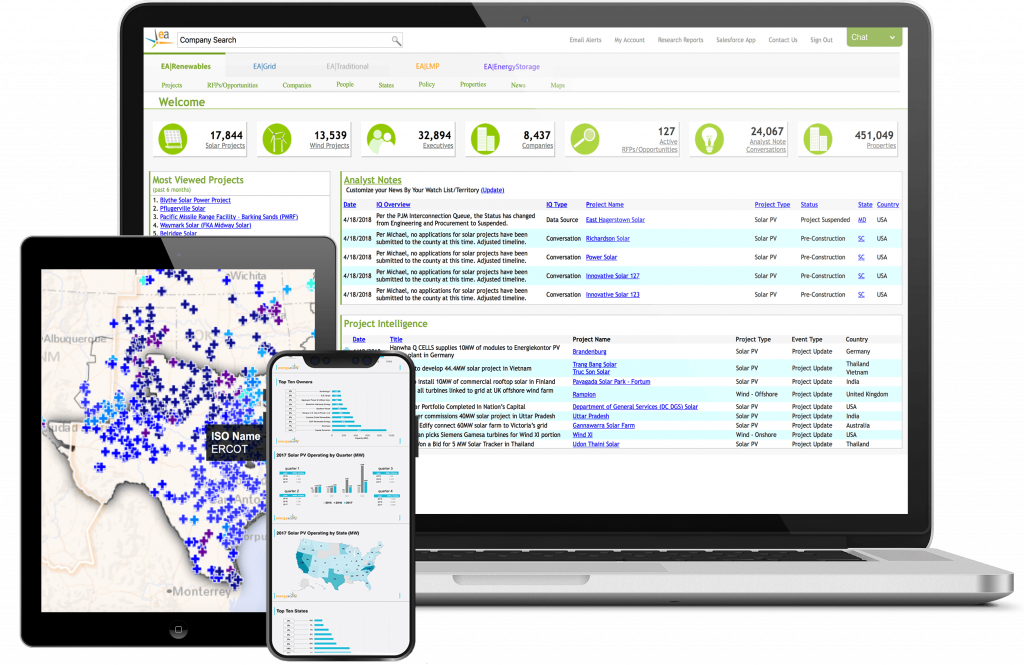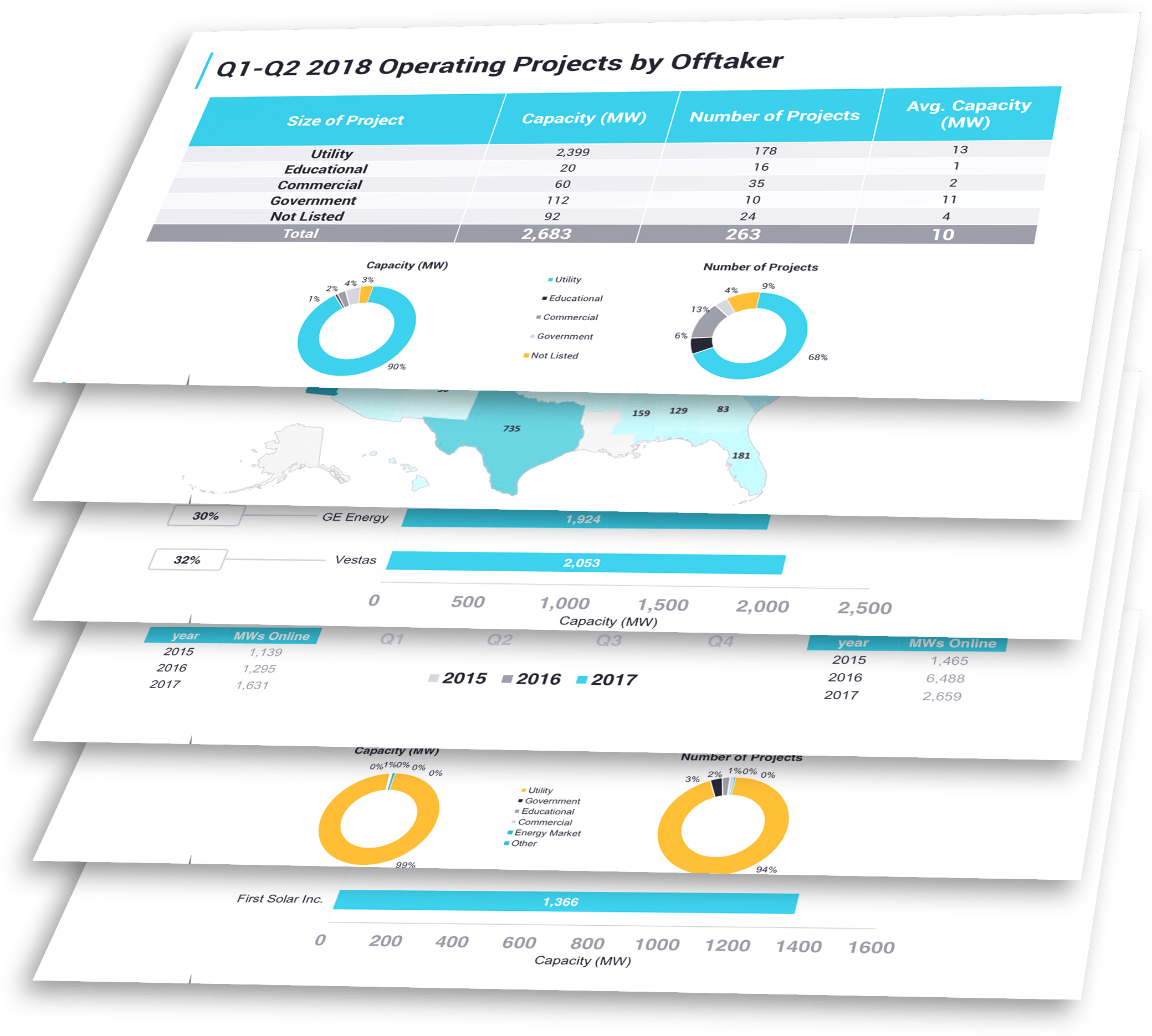
When you think about the top solar states in the U.S., you may have a preconceived idea of which ones make the list. And while some of the leaders in the U.S. solar market are probably those you’d expect, others may surprise you. (For example, the Sunshine State is nowhere to be found on this list!). Take a look at the top five solar states for operating projects in 2016 based on solar capacity by state:
Source: Energy Acuity Renewables Database
The top Solar States For Operating Projects
1. California (3,033 MW)
It’s probably no surprise that sunny California, with its size and historically appropriate climate, tops our list of top solar states for operating projects. In fact, it outshines Nevada, the next-highest state, by more than four times!
In addition to its advantageous climate, changes to the state’s energy infrastructure make solar development poised to continue. According to the Solar Energy Industries Association (SEIA):
“As older fossil-fired and nuclear generation plants (such as SONGS) come offline, statewide carbon reduction efforts escalate, and load growth increases (due, in part, to the anticipated increased deployment of electric vehicles), additional renewable energy procurement will be required within California. These factors, as well as changing consumer behaviors related to electricity production and delivery, offer substantial opportunities to continue to grow the solar energy market in California.”
Additionally, California’s Renewable Portfolio Standard requires investor-owned utilities, electric service providers, and community choice aggregators to increase procurement from eligible renewable energy resources to 33% of total procurement by 2020 (California Public Utilities Commission).
California’s top projects include:

2. Nevada (776 MW)
Like California, Nevada’s climate is well-suited for providing a significant amount of solar power. However, in 2015, “the Public Utility Commission of Nevada changed the net metering policy offered to solar customers in Nevada, which has slowed down distributed generation deployment.” (SEIA)
Despite this setback, solar projects in Nevada continue to grow—Nevada’s Renewable Portfolio Standard requires 25% renewable energy by 2025, and 6% of that is required to be generated by solar facilities beginning in 2016.
Nevada’s top projects include:

3. Georgia (740 MW)
The Peach State ranks third in the top solar states.
“There are more than 197 solar companies at work in Georgia, investing $79 million to install solar on homes and businesses. Georgia has very strong solar potential. State law has made it illegal for Georgia residents to participate in power purchase agreements, a financing mechanism that has been crucial to the growth of the solar industry in other states.” (SEIA)
Georgia Power’s Advanced Solar Initiative (GPASI) is a main driver for growth. In 2016, Georgia Power Co. agreed to add 1,200 megawatts of renewable energy, including solar, to its electrical generation portfolio in the following five years. (Atlanta Business Chronicle)
Georgia’s top projects include:

4. Utah (701 MW)
Utah’s solar projects also continue to grow. Utah’s Renewable Portfolio Standard goal calls for 20% of electricity from renewable sources by 2025—to the extent that it is “cost-effective.” (Energy.gov)
Large retailers in Utah are embracing solar. For example, IKEA installed one of the largest corporate photovoltaic systems in the state with 1,015 kW of solar capacity at their location in Draper. (SEIA)
Utah’s top projects include:

5. North Carolina (545 MW)
North Carolina was the first state in the Southeast to adopt a Renewable Energy and Energy Efficiency Portfolio Standard (REPS), which requires utilities to meet up to 12.5% of their energy needs through renewable energy resources or energy efficiency measures. According to SEIA, North Carolina’s solar industry is growing quickly thanks in part to the state’s REPS, which allows clean energy companies to compete for utilities and offer consumers a choice in their energy supply.
However, North Carolina’s solar boom is expected to wane in the near future as its main utility, Duke Energy, is reportedly attempting to exert more control over the renewable market. If this happens, it would likely put a damper on the pace of project origination.
North Carolina’s top projects include:

Looking for more solar development information?
To learn more about these projects in the U.S. solar energy market—and for more information on other solar projects both operating and under construction—check out the full version of these project profiles in the Energy Acuity Renewables Database.
Source: Energy Acuity
Need Detailed Renewable Energy Intelligence & Analysis? Request a Free Demo of the Energy Acuity Platform Today!

Energy Acuity (EA) is the leading provider of power generation and power delivery market intelligence. EA’s unique approach merges primary research, public resource aggregation, web monitoring and expert analysis that is delivered through a simple, dynamic online platform. This allows our clients to focus on actionable information and win business over the competition.

